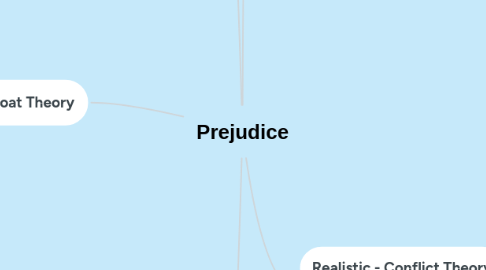Prejudice
by Sophie Gardner

1. Social Identity Theory
1.1. Tajfel (1970's), Bristol boys
1.2. AIM: To demonstrate that putting people into groups is enough for people to discriminate against members of the other group
1.3. METHOD: The study consisted of two laboratory experiments. The independent variable was the type of allocation they were asked to make and the dependant variable was the choices they made (either being fair or showing discrimination)
1.4. RESULTS: They clearly demonstrate that inter-group discrimination is easy to trigger off. The very act of categorisation into groups in enough to produce conflict. In all groups in both conditions gave more money to members of their own group than to members of the other groups. The second experiment also demonstrated that the most important factor in making their choices was maximising the differences between the groups.
1.5. WEAKNESS: It is very artificial. Contains demand characteristics. It has been suggested that if school boys divided into groups by adults, they will automatically think of teams and in terms of competitions.
2. Scapegoat Theory
2.1. Freudian concept - People's hidden unconscious thoughts/ feelings influence their behaviour.
2.2. If we cant display aggression towards source of frustration e.g boss - we can display onto a scapegoat e.g loved one.
2.3. Scapegoat theory is generally applied where there is a sense of deprivation on the part of the person exhibiting prejudice.
3. Reducing Prejudice!!!
3.1. Media
3.2. TV, Films, Social media, News
3.3. Empathy with characters
3.4. Educate on minority issues/ groups
3.5. Affirmative Action
3.6. Overcomes historical disadvantage
3.7. Supported by legislation
3.8. Jigsaw
3.9. Challenge homogeneity
3.10. Challenge stereotypes
3.11. Jane Elliott
3.12. Stereotypes
3.13. Ingroup/ Outgroups
3.14. Empathy
3.15. Curriculum for Excellence
3.16. New direction Scottish education
3.17. Positive schema from early age
3.18. Diversity embraced
4. The Authoritarian Personality
4.1. Adorno (1950)
4.2. Adorno suggested authoritarian personality was created by authoritarian parenting styles
4.3. This style of parenting created aggression, frustration and hatred which are taken out of scapegoats
5. Realistic - Conflict Theory
5.1. Sherif (1960's), Robbers cave study
5.2. AIM: was to see if competing groups developed negative stereotypes of each other
5.3. METHOD (Part 1): 24 boys ages 12. All lower middle class. They formed 2 matching groups who were taken to a camp. They were asked to cooperate and participate in teamwork tasks within their group.
5.4. RESULTS: Developed a sense they were competing against each other. When rewards were introduced rivalry increased. Brought groups together and conflict began
5.5. WEAKNESS: Sample bias - results are only true with 12 year old boys. Also biased to middle class. Boys had just entered puberty so testosterone levels naturally produce aggression.


